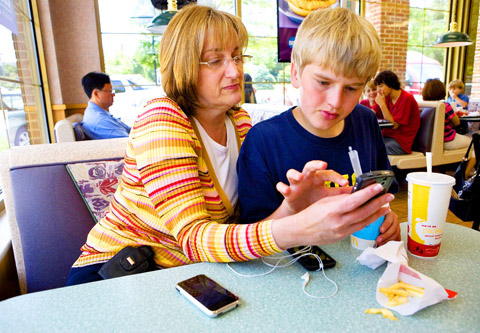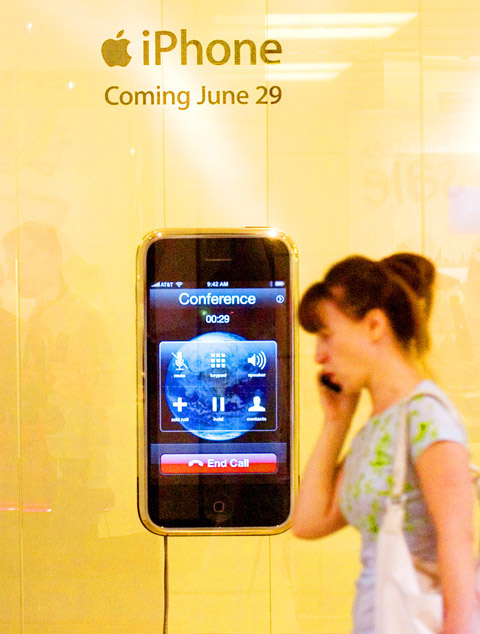If recent history is any guide, roughly a third of the people snapping up Apple’s new iPhone are likely to carry it in a purse.
In a big shift for the phone industry, American women have emerged as eager buyers of not just iPhones but of all so-called smartphones — BlackBerrys, Treos and other models.
In the last year the number of women in the US using smartphones more than doubled to 10.4 million, growing at a faster pace than among men, according to Nielsen Mobile, which tracks wireless trends.

PHOTO: NY TIMES NEWS SERVICE
The trend is mirrored in sales of the iPhone. In October, nearly one out of four owners of the iPhone was a woman, according to Nielsen. By March that number rose to one in three. The iPhone model announced on Monday, with faster Internet access and mapping features, may accelerate the shift.
Smartphones are cheaper now — as little as US$99 for the petite BlackBerry Pearl — and are better designed. Women have been using them for years in business, of course, but many are finding that the phones can also help manage their families’ time-pressured schedules and keep them in touch with friends.
“You are not seen as a geek anymore if you have a smartphone,” said Carolina Milanesi, research director at Gartner Group, a research firm. “Women, including wives and mothers, need to keep track of their busy lives, too.”

PHOTO: NY TIMES NEWS SERVICE
The phone makers and service providers increasingly see women as the path to the entire household. According to Verizon Wireless, 71 percent of American women make the decision about their family’s wireless choices, including phones and service plans. (Smartphones require data plans that can cost US$30 or more a month.)
As a result, smartphone makers are beginning to market specifically to women. Research In Motion, based in Waterloo, Ontario, has taken out ads for its BlackBerry phones in Elle, Martha Stewart Living and Oprah Winfrey’s magazine O.
Lina Caputo, a part-time teacher from Waterloo, said her husband, who runs a networking company that is not connected to RIM, gave her a second-hand BlackBerry a year ago so they could better manage their two sons’ schedules.
Getting In Sync
“It was a nightmare with the four of us,” Caputo said, ticking off a list of her sons’ after-school activities, including soccer, hockey and swim practices. “My sons have about 10 hours of sports. It got to be too much. It was confusing.”
Caputo said she and her husband regularly sync their calendars. She uses the phone to send e-mail to her husband when she gets home safely from a snowy trip, and to keep in touch with close friends who regularly gather at a local coffee shop. When six of them went to Las Vegas for a “girls’ weekend” in February, five of them brought their BlackBerrys so they could keep track of each other and their kids back home.
Caputo is no longer using her husband’s hand-me-downs. On Mother’s Day he bought her a BlackBerry Pearl, one of the company’s best-selling phones. “I don’t equate it to getting a vacuum or a blender,” she said, when asked if she would have rather received flowers or chocolate. “Besides, my girlfriend got a red one for Valentine’s Day.”
David Christopher, the marketing chief of AT&T’s wireless division, said women were less likely to be wowed by fancy gadgets. Instead, as smartphones have become sleeker, smaller and cheaper, they have become more appealing to them.
“Now they are small enough to be in your purse or pocket,” Christopher said. “Design does matter.”
Competitors have been working hard to catch up to Apple in the design department. This month Sprint, will begin selling the Instinct, a touch-screen device created by Samsung that shares many features with the iPhone. And this summer RIM is adding the BlackBerry Bold, which, like the iPhone, runs on a faster mobile network.
Nielsen’s research shows that women are more price-sensitive than men and half as likely to care about whether they have used a specific brand before. Still, more traditional pitches do have their own appeal. RIM and Verizon Wireless were successful last Valentine’s Day with promotional events for a pink BlackBerry Pearl. Even then, picking the right hue was tricky.
“We picked a shade of pink that fit in all kinds of settings — not too flashy,” said Mark Guibert, vice president of corporate marketing at RIM. “It was the only color that was purely driven by the female audience. Years ago the market was much more focused solely on function. Now there is more focus on lifestyle.”
It’s about time, said Milanesi, the research director. When she used to attend mobile trade shows with a male colleague, she said, “they showed him the cool phone and showed me the phone with a mirror.”
“Companies need to be careful to not think that to sell smartphones they just need to be pink,” she said. “There are other things women want.”
Steve Jobs, Apple’s chief executive, understood this when his engineers created the iPhone. Although it is not marketed specifically to women, it has a clean design and multimedia features that many women say they like, but that the BlackBerry lacks.
Kayne Lanahan, who lives in New York and is the owner of an online music site, bought an iPhone last October after her dog wagged its tail and tipped her Nokia cell phone into a cup of coffee. She didn’t even contemplate a BlackBerry, stung by the image of the work-obsessed executives she knew when she worked at the News Corp who furiously e-mailed their bosses during meetings and at the table during late dinners.
“I didn’t want to be that person,” Lanahan said. “This is such a girly thing to say, but I love the iPhone’s design.”
A BLACKBERRY FOR WORK,
AN IPHONE FOR PLEASURE
That, and the fact that the US$399 device suited her technological lifestyle. Lanahan owns an Apple MacBook Pro laptop and five iPods. She uses the iPhone’s notepad function to track restaurant recommendations from friends. She takes pictures at concerts, some of which show up on her Web site. And once, when her name didn’t appear on the guest list at a club she was invited to, she used her iPhone to show the bouncer an e-mail that proved she was invited.
Plenty of other women are finding that smartphones are much more than a tether to the office. According to Nielsen, two-thirds of women with smartphones say they use them primarily for pleasure rather than business. The contrast with men is stark: Just 42 percent of male smartphone owners say the same.
But what is a woman to do if she wants all the features of an iPhone but her corporate e-mail works only with the BlackBerry? In the case of Andrea Newman, a senior vice president of government affairs for Northwest Airlines, she decided to get both.
“I have the BlackBerry for work and I bought the iPhone for fun,” she said. “Using e-mail on the iPhone is more difficult, which is why I use the BlackBerry.”
Still, she liked her BlackBerry so much that she bought one for her 21-year-old daughter so they could communicate when she went to Europe. And for her 12-year-old son she bought an iPod Touch (which can access the Internet over Wi-Fi) so they could e-mail too.
Newman was asked which phone she would keep if she was stuck on a desert island.
“Ewww,” she said. “I never thought about it. Really? If I could only have one?” Minutes passed as Newman weighed the pros and cons of each. Finally, she said, “I guess if I wasn’t using the BlackBerry for work, I’d have an iPhone.”

April 28 to May 4 During the Japanese colonial era, a city’s “first” high school typically served Japanese students, while Taiwanese attended the “second” high school. Only in Taichung was this reversed. That’s because when Taichung First High School opened its doors on May 1, 1915 to serve Taiwanese students who were previously barred from secondary education, it was the only high school in town. Former principal Hideo Azukisawa threatened to quit when the government in 1922 attempted to transfer the “first” designation to a new local high school for Japanese students, leading to this unusual situation. Prior to the Taichung First

The Ministry of Education last month proposed a nationwide ban on mobile devices in schools, aiming to curb concerns over student phone addiction. Under the revised regulation, which will take effect in August, teachers and schools will be required to collect mobile devices — including phones, laptops and wearables devices — for safekeeping during school hours, unless they are being used for educational purposes. For Chang Fong-ching (張鳳琴), the ban will have a positive impact. “It’s a good move,” says the professor in the department of

On April 17, Chinese Nationalist Party (KMT) Chairman Eric Chu (朱立倫) launched a bold campaign to revive and revitalize the KMT base by calling for an impromptu rally at the Taipei prosecutor’s offices to protest recent arrests of KMT recall campaigners over allegations of forgery and fraud involving signatures of dead voters. The protest had no time to apply for permits and was illegal, but that played into the sense of opposition grievance at alleged weaponization of the judiciary by the Democratic Progressive Party (DPP) to “annihilate” the opposition parties. Blamed for faltering recall campaigns and faced with a KMT chair

Article 2 of the Additional Articles of the Constitution of the Republic of China (中華民國憲法增修條文) stipulates that upon a vote of no confidence in the premier, the president can dissolve the legislature within 10 days. If the legislature is dissolved, a new legislative election must be held within 60 days, and the legislators’ terms will then be reckoned from that election. Two weeks ago Taipei Mayor Chiang Wan-an (蔣萬安) of the Chinese Nationalist Party (KMT) proposed that the legislature hold a vote of no confidence in the premier and dare the president to dissolve the legislature. The legislature is currently controlled